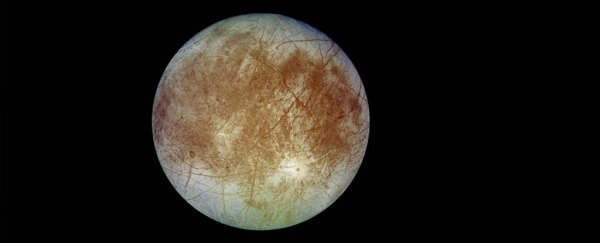Few moons in the Solar System are as intriguing as Jupiter's moon Europa. A global ocean of salt water almost certainly surrounds the moon - and it holds more water than any ocean on Earth.
Above this immense sea, where surface temperatures dip to minus 300 degrees Fahrenheit (-184 degrees Celsius), a crust of water ice forms a shell.
Astronomers predict that Jupiter, which bombards the moon with intense radiation, causes the entire moon to groan with gravity's tug. Europa's liquid water is a tempting target for future missions looking for possible alien microbes.
But before a future lander can search for microscopic ET, the probe might have to contend with a forest of tall, jagged ice spikes. So argues a team of planetary scientists and geomorphologists Monday in the journal Nature Geoscience.
 Penitentes ice formations in Chajnantor, Chile. (ESO)
Penitentes ice formations in Chajnantor, Chile. (ESO)
Their research suggests Europa is an icy hedgehog world, covered in ice formations rarely found on Earth.
On our planet, ice takes several forms, as varied as needle ice, rime, parking lot slush and more exotic lumps. But because Europa's surface is "incredibly cold," said Daniel Hobley, a geomorphologist at Cardiff University in the UK, an author of the study, ice will not melt and refreeze.
Instead, stranger things happen. Ice is not perfectly flat - it's made of little crystals.
"Each of those crystals has potential to lens light," Hobley said, channeling or refracting light down into ice. Over millions of years, energized by the sun's radiation, Europa's ice transforms into gas.
Sunlight alone would not be enough to form huge ice blades. Europa is tidally locked with Jupiter, which means its orbit around Jupiter matches its own rotation.
Put another way, the same face of Europa always faces Jupiter. That also means that the angle of the sun is constant in Europa's sky, Hobley said. The moon has no seasons.
"It's just day-night, day-night, day-night," Hobley said, year after Jovian year.
Hobley and his colleagues considered where on Earth might approximate Europa. They landed on the Andes, the South American mountain range that stretches from Venezuela to Argentina.
At the highest peaks, the Andes has ice - and, in winter, the ice stays too cold to melt. What's more, near the equator, the sun's angle is high and constant, just like it is over Europa's middle.
In the Andes, Hobley and his co-authors knew, an ice formation called penitentes takes shape.
Penitentes are named after an Easter religious festival, practiced by some Spanish-speaking Christians, in which monks wear pointed white hats (the "penitent," hence, penitentes).
Charles Darwin, who made some of the first scientific observations of penitentes in the 1830s, imagined the wind created the ice spikes.
But in 2001, University of Colorado at Boulder physicist Meredith Betterton grew penitentes in a lab via the solid-to-gas process.
At mountain tops, the sun's light carves pits deep in the ice, leaving behind blades twice as tall as they are wide. Penitentes do not form at high latitudes because the sun is too low in the sky in winter; the ice crystals do not funnel the light so sharply downward.
The bottom of these triangular cavities get hotter, and the sides stay cool. On Europa, they would grow "crazy, crazy slow," Hobley said, at about a foot every million years.
But because Europa's surface has been largely unchanged for 50 million years, "they've got a nice long time to do it." Europa's penitentes, the authors calculated, could be almost 50 feet long.
"They have a pretty solid case," said astronomer William Grundy, an expert on icy Solar System objects at Arizona's Lowell Observatory who was not involved with this work.
To be clear, though, this work is a prediction. The conditions are right, but a future observation is required to confirm the penitentes.
Grundy noted that the spatial resolution of Europa images, taken by uncrewed spacecraft like Galileo, are just slightly too fuzzy to make out these features. "Who knows what dragons lurk down there?"
Supporting this argument are radar and temperature imagery.
Europa's midsection absorbs radar, in the way that resembles the "eggcup-shaped sound baffles on recording walls," Hobley said. Which happens to be the shape of penitentes.
What's more, blades of methane ice exist on Pluto. It's also possible, Grundy speculated, that the moons of Uranus - much farther from the sun than Europa - could have bladed terrain of solid carbon dioxide.
As for a landing hazard, the danger is not that a spike will impale a robot. But a probe could very well be lost in one of the pits between the blades, Hobley warned.
Space probes that have attempted landings on asteroids and comets have flipped like flailing beetles or gotten wedged in cracks.
It's not an insurmountable problem, just one of engineering and astronomy. Future landers could aim at a younger region of Europa's surface, where the ice has not had time to form such deep pits.
Higher latitudes, too, should not be covered so thickly in ice blades.
There are two planned orbiter missions to examine Europa: NASA is preparing to launch the Europa Clipper at some point in the 2020s; the European Space Agency's Jupiter Icy moons Explorer (JUICE), is planned to launch in 2022.
Their sensors could confirm or reject the penitente prediction.
Even if Europa's ice blades are too threatening for a lander, a spacecraft might not have to land on Europa to test the hidden ocean. Strong evidence indicates the moon spits plumes of water into space, which an orbiter could swoop up.
2018 © The Washington Post
This article was originally published by The Washington Post.
